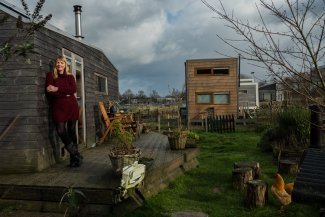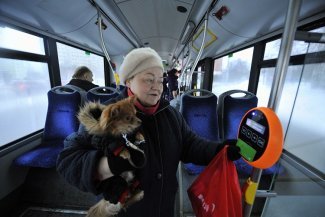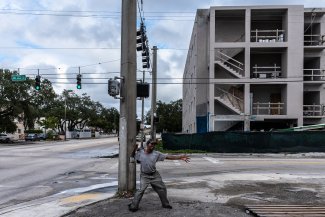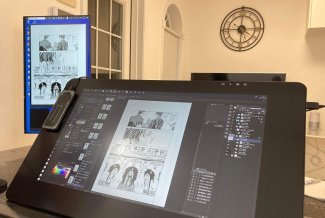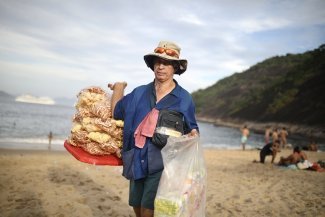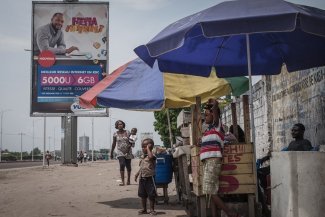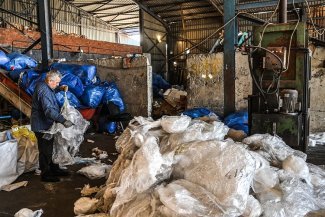Havenlofts, floating wooden villas, were built in 2019, in the disused harbour basin of Nassauhaven in Feijenoord, a low-income neighbourhood in Rotterdam South. There are concerns that projects designed to ‘green’ the city, are having the effect of pushing out poorer, more established communities.
In Rotterdam, housing has replaced the weather as the number one topic of small talk. But while climate adaptation is not yet a popular conversation starter, its consequences already spill over into housing. Over the next 10 years, Rotterdam will invest €233 million in seven urban projects focused on creating more green spaces across the city. As well as increasing protection against flooding and heat – from which the Dutch port city is at spectacular risk – the stadsprojecten (city projects) aim to make Rotterdam more attractive and ensure that most of its inhabitants live within 15 minutes of a green space.
But will everyone benefit from this effort to make Rotterdam a climate-adaptive city? Many are unconvinced. “I’m worried about the effects of the seven city projects on our citizens,” says Rosemarie van Ham, an advisor on inclusive climate policy to the Municipality of Rotterdam. “I want to know if they will benefit Rotterdammers or tourists in the short- and long-term.”
One of the main concerns is the impact of this project on house prices. “If the municipality decides to make small parks, property prices will go up immediately,” asserts Piet Vollaard, a Rotterdam architect, illustrating one of the more contentious outcomes of greening: green gentrification. More green space in an area leads to developers and investors seeking to attract newer, more affluent residents; this increases housing costs, which too often displaces established, lower income, and in many cases, ethnic minority communities.
Kenneth A. Gould, a professor of sociology at Brooklyn College in New York, studied this phenomenon in the Prospect Park neighbourhood of Brooklyn. He discovered that many lower income residents were priced out of the neighbourhood after the park’s renovation in the 1980s. “As the park got cleaned up, property developers started building skyscrapers, advertising proximity to a beautiful green space,” Gould explains.
Greening as a tool of gentrification
Rotterdam’s greening efforts are a decade old, coinciding with the recent attention to climate adaptation. Traditionally a port city, 90 per cent of Rotterdam was destroyed by bombing in the Second World War, after which it was rebuilt full of concrete, with paved-over canals and little attention paid to parks. Today, it is home to almost 650,000 people, 51 per centof which are of non-Dutch origin.
Despite international outcry against the Tweebosbuurt evictions in 2020 – where 535 social homes in a working-class neighbourhood were demolished by the city council and replaced overwhelmingly by private-sector rentals, without proper consultation or adequate assistance with rehousing – today, there is evidence that authorities are using greening as a gentrification tool. Rotterdam’s Woonvisie, the municipal vision for 2030, aims – amongst other things – to draw in more citizens of above-average income.
Upgraded neighbourhoods will include attractive housing with extensive green spaces. Urban planner at Rotterdam city council, Maartje Visser, who’s responsible for the greening, explains that “greening is a way to make the city more attractive to live in but also for international companies, so it attracts investment.”
Following the Tweebosbuurt scandal, the city council has introduced various anti-gentrification measures: a ban on certain property purchases for international investors; the obligation to live in a house one buys; and rent freezes for those at the bottom of the social housing ladder. “We pay more attention to inclusivity and [try to] facilitate an attractive city for all Rotterdammers, including the working-class and low-income people now,” Visser states.
But there is a blind spot. “We still don’t have enough information about green gentrification and its effects on the city,” says the municipality’s inclusivity advisor, Van Ham. “Mainly because of lack of research.”
For example, no rules currently prevent price increases after ‘upgrading’ housing with green or energy-efficiency measures; as a result, housing corporations can increase rents after planting trees or retrofitting apartments, for example.
The impact of green gentrification is clear in the DakPark and Hudsons developments in the Bospolder neighbourhood of Rotterdam West. DakPark combines climate adaptation with recreation: on a dike and with water buffers, the pastoral rooftop park hosts a community garden, a shopping centre, and offers the largest green space in the area.
The construction of the Hudsons apartment complex started two years after DakPark opened in 2014. Although the Municipality of Rotterdam financed the park, private developers reaped its rewards by advertising “City living with a backyard” and pricing the units accordingly – between €347,500 and €465,000 for a two-bedroom flat. The 145 apartments for sale were unattainable for most Bospolder inhabitants, whose average yearly income was €24,162 in 2022.
Traditionally an area with a large percentage of low-income populations of migrant backgrounds, the building boom that followed the development of DakPark has resulted in a change to the area’s ethnic mix – another marker of gentrification. According to research conducted by the Central Bureau of Statistics between 2014 and 2022, 4 per cent of non-white migrants* moved out while almost 3 per cent more Western migrants*, likely expats, moved in. Besides, property prices rose more than the Rotterdam average.
Several buffers can delay the negative effects of green gentrification. Rotterdam’s housing market is still regulated: corporations accommodating the poorest people hold around 40 per cent of city property, with the municipality responsible for another 40 per cent. “Areas with more robust social housing programmes tend to see slower green gentrification,” James Connolly, assistant professor at the University of British Columbia who researched green gentrification in Barcelona, explains.
Proactive citizens also can curb its negative effects. Bospolder is a lively neighbourhood with deeply rooted social connections – the citizens requested the DakPark and maintain it. “A pre-organised community with its own vision for development is key,” Gould states.
Nassauhaven: slow gentrification and a policy mismatch
Eighteen, energy-neutral wooden villas known as Havenlofts float in the long-abandoned harbour basin of Nassauhaven in Feijenoord, Rotterdam South. Billed as offering an innovative solution to the limited construction space in the city and designed to “attract a new group of citizens”, most of the area’s old inhabitants were priced out as the houses sold for between €395,000 and €505,000 in a neighbourhood with the second-to-lowest yearly income in Rotterdam.
The Netherlands is pioneering floating structures – houses, offices, and even a farm – as a result of scarcity of land in relation to its population density, worsening flooding, and to assist the country’s branding as an international climate adaptation leader.
Yet, innovative architecture cannot solve all problems. And there are many in Feijenoord. “Here, we spend time figuring out how to get by every month,” says Adel El-Aiboudi, 39, who lives locally and works in healthcare. “We need to pay our living against inflation. We don’t have time to talk about pretty flowers or sustainability.”
The gap between the old and new dwellers is painfully obvious. “My house faces the floating houses. I look at them through my window every day, but they feel very far away,” says Said Aharchaou, a 55-year-old youth worker. “We don’t feel connected with these people. They’re nice but living luxuriously and occupied with different issues.”
Nassauhaven illustrates a mismatch between what some Rotterdammers need and what the city delivers. Between 2014-2022, according to city council data, jobs in the neighbourhood shrank but property prices increased by a quarter against the Rotterdam average. “In Feijenoord we need more jobs, more security on the streets,” El-Aiboudi proclaims.
Environmental justice researcher Gould speaks of the “sustainability class”: residents attracted to an area based on its urban and environmental qualities. They are “educated, higher-class professionals”; precisely the kind of people the municipality wants to attract – even if they don’t already live in Rotterdam.
Energy poverty provides another illustration of inadequate policymaking. Delfshaven, where Bospolder lies, and Feijenoord, have the highest rates of inefficient housing in Rotterdam. Retrofitting houses to a higher energy class would yield greater environmental and social benefits than building near-energy-neutral, climate-adapted, but largely unaffordable new housing. “Sometimes in Rotterdam, I feel like property rights go above human rights,” van Ham asserts.
Hofbogenpark: “a great example of government-driven gentrification”
One of the planned ‘city projects’, the Hofbogenpark in Rotterdam North, is already causing concern. It will span over almost two kilometres on old train tracks. However, underneath the railway arches, gentrification has already set in. Despite a lot of social housing in the area, property prices are exploding.
“Hofbogen is a great example of government-driven gentrification,” architect Vollaard asserts. Less than a decade ago, when the trains stopped running and before the Dutch real estate firm Dudok Group acquired the tracks, the area was bustling with small businesses. “Those places are not available anymore,” Vollaard states.
The neighbourhoods linked to Hofbogenpark offer more job opportunities now. Yet, whether job quality compensates for price increases is a much more complex question. The park will open in 2024. “We need to ask whether the park will bring gentrification in the neighbourhood,” van Ham says. “Or is it already happening?”
Preventing green gentrification requires extra reflection from urban planners. The health and climate adaptation benefits of green public spaces are undeniable: trees offer shade during heatwaves and counter floods, for example. But if created without concern for equity, green spaces can cause discontent.
The seven city projects, for example, will likely exacerbate the area’s already existing housing problems. Van Ham advocates discussions on inclusivity at all stages of a project. “Maybe we didn’t have the knowledge [of green gentrification] when we designed the projects six years ago, but we can still talk about how to make them more inclusive,” she states.
Inspiration flows from other cities. L’Innesto in Milan is the first carbon-neutral social housing project in Italy, hosting 400 units and residential space for 300 students. In another example, in one of the most vulnerable neighbourhoods in Los Angeles, the Watts Rising Transformative Climate Communities project develops green spaces, installs clean energy, and creates jobs while preventing displacement.
The good news is that Rotterdam is slowly acknowledging the problem. Rosemarie Van Ham leads the city council’s Inclusive Climate Action Rotterdam programme, and is tasked with conducting research and advising various departments. The initiative encourages cautious optimism that equity will join environmental and economic aspects in project evaluations.
“We’re living in a time when inclusion and diversity are very important,” van Ham states. “We’re trying to inspire and educate municipal workers to look at their areas through an inclusion lens.”




